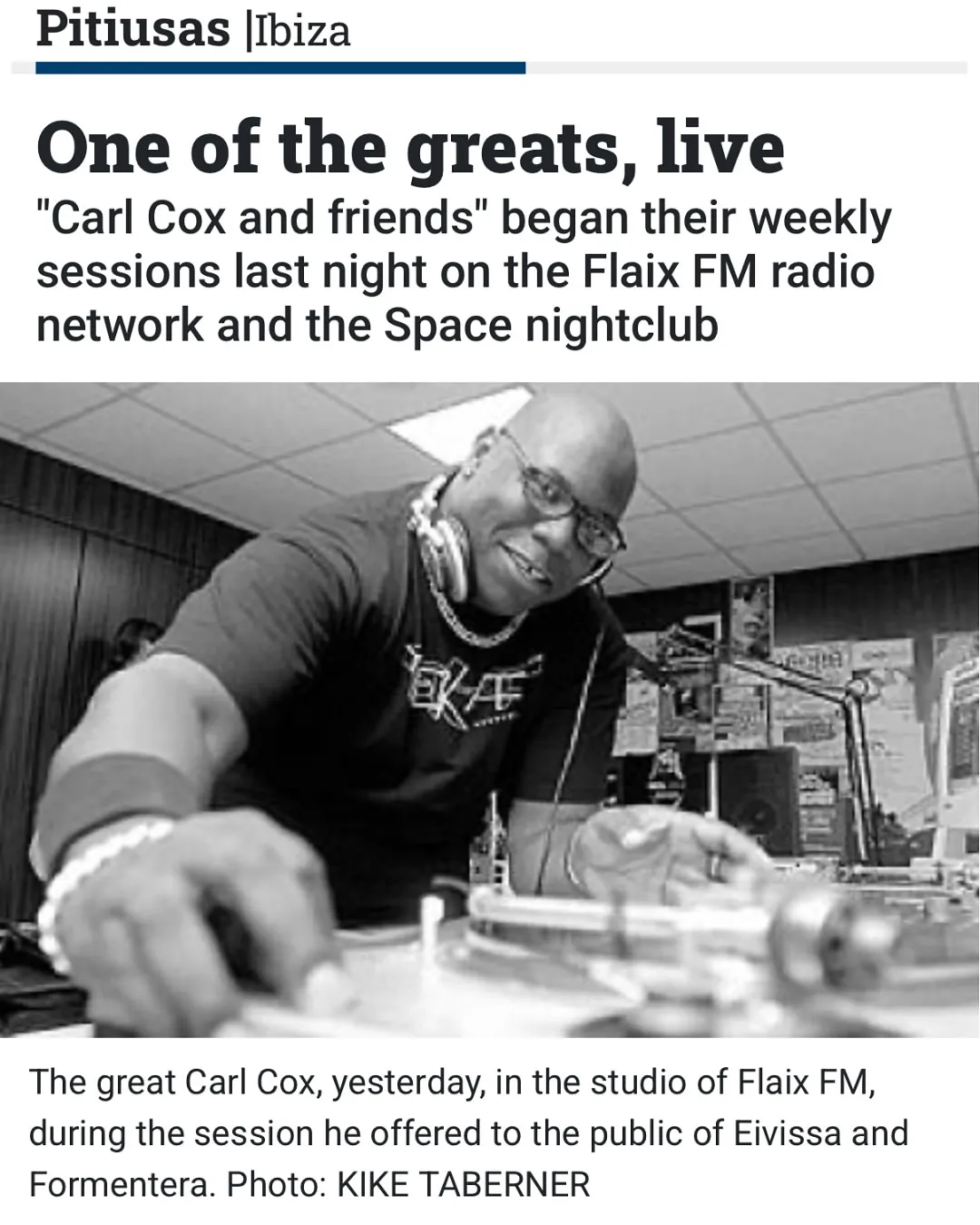

Carl Cox’s Timeless Legacy: How He Created Flaix FM 105.0 and How It Influenced the Rave Community of the Time
When we talk about the golden era of electronic music, the conversation often drifts to legendary clubs like Space Ibiza, Amnesia, or Pacha. Yet, there is one element often overlooked but equally essential to the culture: radio. Before the rise of streaming platforms, before SoundCloud uploads and Spotify playlists, radio was the beating heart of electronic music culture. Among these, Flaix FM 105.0 in Ibiza became an institution. For ravers, DJs, and producers, it wasn’t just a frequency on the dial—it was the pulse of a generation.
This article dives deep into the meaning of Flaix FM 105.0 for the rave community, exploring its connection to Carl Cox, David Moreno, and the broader evolution of Ibiza’s music culture. From the booths of radio to the DJ cabins of Space, from vinyl mixes to digital nostalgia, we’ll uncover why the station continues to resonate with fans decades later.
Carl Cox and the “Golden Memories” of Ibiza Radio
Carl Cox’s Journey Through Ibiza Radio
Few names carry as much weight in the world of house and techno as Carl Cox. Known as the “People’s DJ,” Cox has always been more than just a selector of tracks—he’s a storyteller, a cultural archivist, and an ambassador of rave culture. His connection to Ibiza Radio, particularly Flaix FM 105.0, reflects the pivotal role broadcasting played in shaping the island’s reputation as the global hub of electronic music.

For Carl Cox, joining David Moreno on Ibiza Dance wasn’t just another gig—it was a piece of living history. Radio allowed him to share not just tracks but also the vibe, the energy, and the storytelling that made the rave scene more than just music.
Why Flaix FM 105.0 Was Crucial for Ravers
In the 1990s and early 2000s, access to underground music wasn’t as simple as clicking on a Spotify playlist. Flaix FM 105.0 brought exclusive DJ sets, unreleased tracks, and live Ibiza energy into homes, cars, and beach parties. For ravers who couldn’t always be on the island, the station became a lifeline.
Radio shows often previewed the tracks that would later become dancefloor anthems. They also fostered a sense of community, connecting listeners across Europe who tuned in religiously. This was the power of radio before social media—it created shared experiences in real time.
The Influence of David Moreno and the Ibiza Dance Legacy
David Moreno: A Pioneer of Ibiza’s Sound
You cannot talk about Flaix FM 105.0 without mentioning David Moreno. Launching Ibiza Dance in 1989, Moreno became a central figure in transforming Ibiza into the “capital of electronic music.” His show was not just about playing records—it was about curating an atmosphere, introducing new artists, and documenting the rise of club culture.
Moreno helped to establish Ibiza as more than a holiday destination—it became a spiritual home for ravers worldwide. Flaix FM, through his work, was the sonic bridge that connected the local island scene with global audiences.
Carl Cox and David Moreno: Two Icons Sharing Decks
One of the most iconic memories is seeing Carl Cox and David Moreno together, sharing stories, decks, and vibes. As Carl Cox himself recalls, those sessions were pure magic. It was more than music—it was about energy, camaraderie, and the essence of rave culture.
When Cox joined Moreno on Flaix FM, it symbolized a generational passing of the torch. Both were pioneers in their own right, and together they created a shared narrative that reinforced the island’s reputation as the epicenter of global clubbing.
From Radio Booths to DJ Cabins at Space
The Atmosphere of Space (Ibiza)
If Flaix FM was the voice of rave culture, then Space Ibiza was its heartbeat. Tuesdays at Space, as Carl Cox recalls, became legendary. The club wasn’t just a venue—it was a temple for electronic music, a place where analog energy and human connection ruled the night.
Radio brought the sound, but clubs brought the physical experience. Fans who first discovered tracks on Flaix FM could later dance to them live at Space. This synergy between radio and club culture created a unique loop that kept the community tightly connected.
Radio Listening vs. Dancefloor Experience
Comparing radio sessions with club nights reveals two sides of the same coin:
-
Radio offered intimacy. Listeners tuned in from their bedrooms, cars, or beachside gatherings. It was personal, almost secretive.
-
Clubbing offered intensity. Thousands of people packed into Space, moving together to the same frequencies they once discovered alone.
This duality made the culture richer. Radio introduced the music; the club transformed it into ritualistic experiences.
Nostalgia in EDM and the Return to Analog
Vinyl and the Energy of the 90s–2000s
Carl Cox often highlights the “analog energy” of those days—vinyl decks, needle drops, and raw sound quality that digital platforms cannot fully replicate. In the 90s and early 2000s, every mix carried imperfections, but those imperfections added personality.
Flaix FM broadcasts from that era preserved this authentic vibe. When Carl Cox references a 2001 mix capturing the essence of Ibiza, he’s pointing to a moment in time when rave culture was still unfiltered, unpolished, and raw.
Why Old Mixes Still Inspire Today
The comments under Cox’s social media posts prove this point. Younger DJs like Metodi Hristov openly express their desire to remix tracks like Give Me Your Love or the sets from Flaix FM. These aren’t just songs—they are sources of inspiration that fuel creativity for a new generation of producers.
By revisiting these archives, Cox and Moreno remind the world that the roots of EDM are timeless. The energy of those old mixes transcends decades, showing how analog vibes still connect with digital-age fans.
DJs “Digging in the Archives”
Today, many DJs actively search for forgotten vinyl, old radio sets, and archived mixes. This trend reflects a broader cultural hunger for authenticity. As electronic music grows more commercial, going back to its roots provides a refreshing reminder of what made it powerful in the first place. Flaix FM’s legacy lives on because it represents exactly that.
Carl Cox: A Living Legacy of Ibiza Culture
More Than a DJ: A Keeper of Collective Memory
Carl Cox’s recent Instagram posts revisiting his time on Flaix FM with David Moreno highlight something crucial: he is not just performing; he is curating a collective memory. By sharing these snapshots, Cox ensures that the rave generation of the 90s and 2000s doesn’t fade into obscurity.
For many fans, Cox embodies the bridge between past and present. He keeps the energy of Ibiza alive—not just through sets but through storytelling. And storytelling is essential to keeping cultural heritage alive in the age of digital noise.
Social Media as a Modern Archive
While Flaix FM used radio waves to reach audiences, Carl Cox now uses social media platforms to carry the same mission. His Instagram posts showcasing old records, photos with Moreno, and archived mixes generate thousands of reactions. Fans relive the past, while younger generations discover it for the first time.
In this way, Cox has transitioned from vinyl decks to digital feeds while preserving the same core mission: to connect people through the spirit of rave.
Conclusion: Why Flaix FM 105.0 Will Always Matter

Flaix FM 105.0 was not just another radio station. It was a cultural institution that helped define rave culture at a time when access to underground music was scarce. Through the vision of David Moreno and the energy of Carl Cox, it became a gateway to Ibiza’s magic, a platform that connected ravers across the globe.
Its significance lies in several key areas:
-
It made Ibiza the epicenter of electronic music, long before streaming or social media.
-
It gave DJs like Carl Cox a platform to connect with fans beyond the club scene.
-
It created a shared cultural memory, preserved in mixes and recordings that still inspire today.
-
It showcased the timeless power of analog energy, vinyl, and authentic human connection.
As the EDM industry evolves, Flaix FM remains a reminder of the foundations. In every nostalgic mix, every throwback photo, and every DJ digging into archives, the spirit of Flaix FM 105.0 continues to echo.
Carl Cox, David Moreno, and the entire Ibiza scene ensured that radio waves became cultural waves, and those waves are still crashing today. For ravers, Flaix FM is not just history—it is heritage.


















